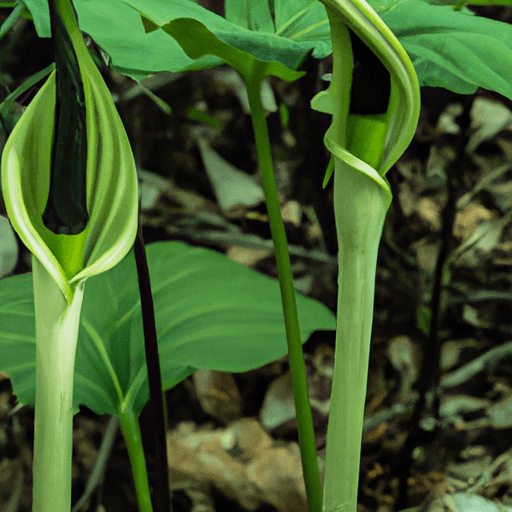Jack-in-the-Pulpit is a fascinating and unique plant that thrives in shady environments, requiring some shade to grow well. It prefers damp, acidic soil that is rich in organic matter and needs consistent moisture for optimal growth. This hardy plant, which can be found in zones 4a to 9a, prefers damp and humid conditions.
With its various types and subspecies, Jack-in-the-Pulpit offers a range of characteristics. Propagation can be done by splitting off cormlets, while growing from seed requires cold stratification.
This article provides tips and insights on growing and caring for this intriguing plant, including ideal growing conditions, propagation techniques, and more.
Ideal Growing Conditions for Jack-in-the-Pulpit
Jack-in-the-Pulpit performs well in deep shade and requires some shade, preferring damp, acidic soil rich in organic matter. Maintaining evenly moist soil is essential for its growth.
This plant thrives in damp, humid conditions and is hardy in zones 4a to 9a. When it comes to care and maintenance, fertilizing with compost is usually sufficient, but an acidifying fertilizer can be used if needed. Mulching helps maintain soil moisture, and regular watering is necessary when planted with viburnum shrubs.
Lack of shade and poor soil conditions can prevent flowering. Overall, Jack-in-the-Pulpit has specific soil requirements and shade preferences, and proper care and maintenance are crucial for its successful growth.
Different Types and Varieties of Jack-in-the-Pulpit
Arisaema consanguineum, one of the types of Jack-in-the-Pulpit, displays purplish stripes and resembles a cobra’s head. This unique characteristic sets it apart from other varieties.
Jack-in-the-Pulpit cultivation does come with its challenges, but with the right care, it can thrive in your garden.
Here are some of the unique characteristics of different Jack-in-the-Pulpit varieties:
- Arisaema saxatile has a white spathe and a long spadix.
- Arisaema griffithii has an elaborate light-green veining pattern.
- Arisaema triphyllum is the most common variety, featuring a green spathe and a spadix.
Each variety of Jack-in-the-Pulpit brings its own beauty and charm to the garden. By understanding the unique characteristics of each variety, you can create a diverse and visually appealing display.
Propagation Techniques for Jack-in-the-Pulpit
To propagate Jack-in-the-Pulpit, one can split off the cormlets from the main root clump in the fall and replant them in humus-rich soil with light shade.
Cormlet division is a common and effective propagation method for this plant. In the fall, the entire root clump should be carefully dug up, and the offsets, or cormlets, can be separated from the main corm.
These cormlets should then be replanted in a suitable location, ensuring that the soil is rich in organic matter and provides light shade. Adequate watering and mulching are important for the successful establishment of the propagated cormlets.
This method allows for the production of new plants and is a reliable way to expand a Jack-in-the-Pulpit population.
Tips for Growing Jack-In-The-Pulpit From Seed
Germination of Jack-in-the-Pulpit seeds can be achieved by providing the necessary cold stratification for at least 60 days. This process mimics the natural conditions the seeds would experience in their native habitat. Here are some tips for germinating and caring for Jack-in-the-Pulpit seeds:
-
Cold stratification: Keep the seeds damp in sphagnum moss in a refrigerator for the required period of time.
-
Sowing the seeds: Once stratified, sow the seeds in a flat filled with soilless potting mix.
-
Ideal conditions: Place the flat in a cool, damp location to encourage germination.
-
Seedling care: After germination, continue growing the seedlings in the flat for two years before transplanting them.
Overwintering, Pest Control, and Additional Insights
Slugs can be effectively controlled in the garden by placing a dish of beer to attract and drown them, ensuring the health and vitality of the Jack-in-the-Pulpit plant. Overwintering techniques and natural pest control are essential for the successful growth of this unique plant. During winter, Jack-in-the-Pulpit is hardy in zones 4a to 9a and requires no winter protection. Fallen leaves and plant debris provide essential nutrients and moisture for the plant. However, slugs can be a common pest and can damage the plant if left unchecked. By placing a dish of beer in the garden, slugs will be attracted to the scent and drown in the liquid. This natural pest control method helps to protect the Jack-in-the-Pulpit plant from slug damage and maintains its overall health and vitality.
| Overwintering Techniques | Natural Pest Control |
|---|---|
| Hardy in zones 4a to 9a | Placing dish of beer |
| No winter protection required | Attracts and drowns slugs |
| Fallen leaves and plant debris provide nutrients and moisture | Ensures health and vitality of Jack-in-the-Pulpit |
Frequently Asked Questions
Can Jack-In-The-Pulpit Be Grown in Full Sun or Does It Require Shade?
Growing jack-in-the-pulpit in full sun is not recommended as it prefers shade. Proper watering techniques are important for its growth. It thrives in damp, humid conditions and requires evenly moist soil.
How Often Should Jack-In-The-Pulpit Be Watered?
Jack-in-the-Pulpit should be watered regularly to maintain evenly moist soil. The ideal soil conditions for this plant include damp and acidic soil rich in organic matter.
Are There Any Specific Fertilizers That Should Be Used for Jack-In-The-Pulpit?
Specific fertilizers for Jack-in-the-Pulpit are not mentioned in the Current Question. However, organic fertilizers are beneficial for the plant, providing essential nutrients in a natural and environmentally friendly way.
Are There Any Natural Predators or Diseases That Commonly Affect Jack-In-The-Pulpit?
Natural predators of jack in the pulpit include browsing animals like rabbits and deer, which generally avoid the plant due to its toxicity. As for diseases, while there are no specific diseases that commonly affect jack in the pulpit, it is important to maintain proper growing conditions to prevent any potential issues.
How Long Does It Typically Take for Jack-In-The-Pulpit to Bloom After Planting?
Jack-in-the-Pulpit typically takes four to five years to bloom after planting. Factors affecting blooming time include shade, soil conditions, and adequate moisture. Best practices for planting and care include providing shade, organic-rich soil, and regular watering.







